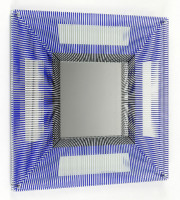
Details
Artist
Styles
Box with 40 colored steel bars with colored back; sculpture box; in pencil at the back; in mint condition // Prochromatique 1 by Dario Perez-Flores, created in 2010, is a vibrant mixed-media piece contained within a black frame. The artwork features 40 colored steel bars arranged in vertical lines, each displaying a unique hue. This arrangement creates a rhythmic, chromatic effect that shifts subtly with the viewer's movement, giving the piece a dynamic, kinetic quality. The interplay of colors—ranging from vivid reds and blues to softer pastels—produces a mesmerizing visual experience that highlights the artist’s exploration of color, light, and perspective. The structured yet fluid composition invites contemplation of both order and optical play.
Prochromatique 1, 2010
form
Medium
Size
53 x 53 X 7 cm
- Inches
- Centimeters
Edition
Price
- USD
- EUR
- GBP
Details
Artist
Styles
Box with 40 colored steel bars with colored back; sculpture box; in pencil at the back; in mint condition // Prochromatique 1 by Dario Perez-Flores, created in 2010, is a vibrant mixed-media piece contained within a black frame. The artwork features 40 colored steel bars arranged in vertical lines, each displaying a unique hue. This arrangement creates a rhythmic, chromatic effect that shifts subtly with the viewer's movement, giving the piece a dynamic, kinetic quality. The interplay of colors—ranging from vivid reds and blues to softer pastels—produces a mesmerizing visual experience that highlights the artist’s exploration of color, light, and perspective. The structured yet fluid composition invites contemplation of both order and optical play.
- Recently Added
- Price (low-high )
- Price (high-low )
- Year (low-high )
- Year (high-low )
What is contemporary art?
Contemporary art refers to avant-garde or innovative art created in the recent past or present day. The exact starting point of contemporary art varies depending on the institution, often tied to the founding year of museums or galleries that showcase the style. Contemporary art is characterized by its focus on current ideas, diverse media, and the exploration of new concepts and techniques.


























